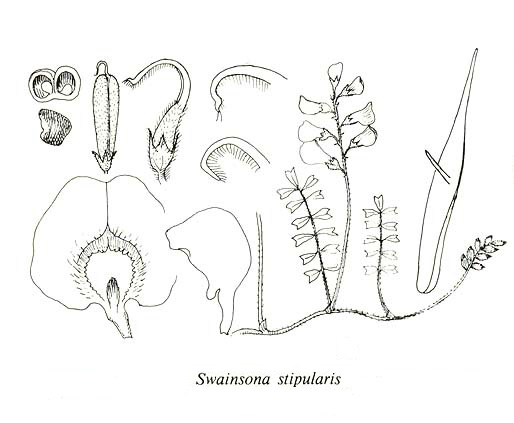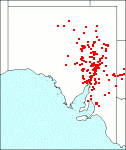Family: Fabaceae
Swainsona stipularis
Citation:
F. Muell., Linnaea 25:393 (1853).
Synonymy: S. phacifolia F. Muell., S. Aust. Register 14, 1048:3 (1850), nom. nud.; S. stipularis F. Muell. var. geniculata J. Black, Fl. S. Aust. 473 (1948), nom. nud.; S. stipularis F. Muell. var. longialata A. Lee, Contr. N.S.W. natn. Herb. 1:213 (1948); S. stipularis F. Muell. var. purpurea A. Lee, Contr. N.S.W. natn. Herb. 1, 4:213 (1948).
Common name: Orange Darling pea.
Description:
Perennial bushy spreading herbs; pubescence of short flattened white appressed hairs; stems 10-55 cm long; leaves 6-8 cm long; leaflets 7-13, the apical lanceolate to oblong and the largest, the lateral ones from linear-oblong to narrow-oblong or oblong-cuneate, retuse, 9-12 (rarely to 20)mm long, rarely 1 commonly 2-4 mm broad, or only 3 mm long and 2 mm broad, notched or almost 3-toothed at the summit, broadly cuneate-truncate, rarely glabrous, usually less densely pubescent above than below; stipules large (to 10 mm or more), irregularly toothed, but sometimes small, narrow-deltoid and entire or almost so, with pubescence like that on the leaves.
Flowers commonly 10-12 sometimes 15 mm long in loose 5-20-flowered racemes, on the distal third of the 10-30 cm long peduncles which are pubescent as is the stem; bract ovate-acute, to 2 mm long, scarious, glabrous inside; bracteoles attached at the base of the calyx tube, ovate-deltoid, to 1 mm long, obscured by hairs; calyx 5-8 mm long, rather densely pubescent with basi- and medifixed dark and/or white hairs, spreading loosely above the 2-4 mm long pedicel; teeth triangular, shorter than the tube; petals reddish-brown, orange (drying purple) or purple at first; standard broadly ovate to orbicular, a little broader than long, shallowly notched, often with conspicuous yellowish-green blotches centrally, ecallose or with 2 puncrate calli sometimes indistinct or with 2 longitudinal folds or ridges on the claw which are often fused with calli into a cross-ridge; claw broad, 2-4 mm long, slightly folded and twisted sideways, supporting the lamina in a position oblique to the keel; wings generally obovate and more than 4 mm wide, auricle sometimes ciliate; claw narrow, 2-5 mm long; keel indistinctly twisted sideways or quite straight; lamina semicircular, generally with an obtuse wide beak, usually with 2 distinct pouches or folds; ovary on a short and stout gynophore less than 1 mm long, cylindrical, rarely glabrous, usually with appressed pubescence and with a band of longer and spreading hairs along the suture; style rigid, dilated and slightly flattened basally, with a sickle-like curve, bearded in the distal half or only near the tip; tip incurved, broadly hooked or slightly recurved or geniculate, without hair-tufts behind the stigma.
Pod cylindrical, 20-30 x c. 5 mm, deeply impressed along the suture, becoming glabrescent, reticulate, downy, style persisting as a short beak, to 20-seeded; seed cordate, 1.5-2 mm across, olive-green, mottled brown.

|
|
Image source: fig. 340A in J.P. Jessop and H.R. Toelken Ed. 1986. Flora of South Australia (4th edn).
|
Published illustration:
Rotherham et al. (1975) Flowers and plants of New South Wales and southern Queensland, p. 152.
|
|
Distribution:
|
S.Aust.: LE, GT, FR, EA, EP, NL, MU, YP, SL. W.Aust.; Qld; N.S.W.; occurs mainly in the southern and arid part of Australia.
|
Conservation status:
native
Flowering time: July — Oct.
|

SA Distribution Map based
on current data relating to
specimens held in the
State Herbarium of South Australia
|
Biology:
Regarded as good fodder but abundant only in better seasons.
Taxonomic notes:
As observed, var. stipularis differs from var. longialata and var. purpurea chiefly in their purple flower colour, though this may not be constant; on the standard the calli are sometimes fused to 2 more or less parallel folds or ridges at the base of the petal, or only the ridges are present, which are sometimes indistinct; keel shape is very constant, as is described, but the narrowly obtuse shape (of var. longialata) was not seen in material examined and the strongly twisted keel which is less twisted in var. purpurea or almost straight in var. longialata were indistinguishable in pressed specimens as all show some degree of twisting. The wings generally have a broad lamina more than 4 mm wide and remarkably uniform in shape. As predicted by A. Lee, her treatment appears to "need to be revised" and, in the light of recent collections, I believe that her varieties should be treated as synonyms.
A. Lee (1948) divided the species into 3 varieties as follows.
Key to Infraspecific taxa:
|
1. Keel distinctly twisted sideways; standard ecallose or with small puncrate calli; flowers reddish or brown; wings almost orbicular in the upper half |
|
var. stipularis |
|
1. Keel scarcely twisted, or straight; standard with longitudinal folds; flowers purple; wings as in var. stipularis or oblong |
|
|
|
2. Wings almost orbicular in the upper half or, if oblong, usually smaller than in var. longialata; keel with a slight twist sideways |
|
var. purpurea |
|
2. Wings long and broad, 12 x 3 mm; keel narrowly obtuse, not twisted |
|
var. longialata |
Author:
Not yet available
|

